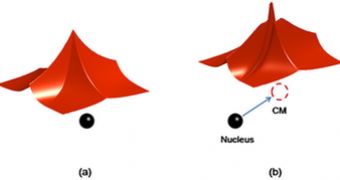While in school, science taught us that atoms are made of two major components: the nucleus and the electronic shell orbiting around nucleus. Atoms may lose or gain electrons and neutrons during certain interactions. The number of neutrons inside an atom determines the type of isotope associated with the respective chemical element. However, what is the atom that somehow loses its nucleus leaving behind only the electron shell? What should we call that?
We can't call it an atom, that's for sure. An atom is closely defined by its nucleus. The two physicists proposing this concept are John Briggs and Darko Dimitrovski from Freiburg University. They believe that such a structure could be created and maintained in a stable configuration for small amounts of time. "Maybe we can call it and 'atom without a nucleus or a 'filleted atom'," says Briggs.
With the help of an attosecond laser it is theoretically possible to eject the nucleus out of the electronic shell, without the loss of the shape of their orbital trajectories around the nucleus. The biggest problem is that the nucleus is all that keeps the electrons from flying away into space. Once the nucleus is removed, the electrostatic forces produced by individual electrons immediately repel them from one another, destroying the structure of the shell in the process.
Attosecond lasers, on the other hand, could be able to cheat this little problem. Inside hydrogen atoms, the electron requires 24 attoseconds to orbit the nucleus, however on top of being extremely short, the laser pulse must also be very powerful, so that the energy introduced into the atom will be greater than that of the sum of forces that keep the electrons around the nucleus.
For example, a 10 attosecond burst of laser light with a power of 1018 watts would be just enough to remove all electrons from a particular atom. At the same time, the half cycle of the laser pulse would transfer momentum to the electrons so that the shape - wavefunction - of the electronic shell is maintained.
Albeit theory predicts that a single half-cycle cannot be produced, in order to resolve this physicists propose that the second half-cycle could be used to stop the wavepacket from moving too far from the nucleus, resulting in a nucleus and an electron shell in its close vicinity, instead of a regular atom. Theoretical calculations show that, by applying this method, not just one but multiple electron atoms could be produced.
All that remains to be done is to build a powerful attosecond laser. "We conceived this as a 'sexy' little experiment. However, the real message of the paper is that one should be able to fully ionize an atom or molecule and then control and manipulate, by further half-cycle momentum kicks, the state of the continuum electron wavepacket. The possibility of observing rather directly the spatial bound-state atomic wavefunction moving nucleus-free, essentially undistorted, is just one example of this general technique that the development of strong attosecond lasers will make realizable," said Briggs.

 14 DAY TRIAL //
14 DAY TRIAL //